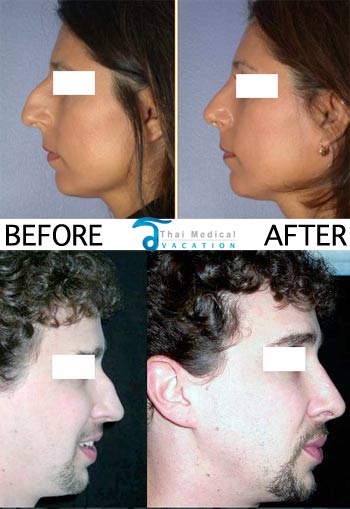Rhinoplasty & Nose Augmentation Surgery in Thailand
Rhinoplasty Surgery is also known as a Nose Jobs or just Nose Surgery. Augmentation Rhinoplasty is one of the most popular treatments for both women and men around the world looking to reshape their noses after an injury or to re-build self-confidence by changing their outward appearance. Thai Medical Patients choose to come to Thailand for Rhinoplasty for many reasons but generally the biggest reason is the skilled cosmetic surgeons who have performed thousands of successful surgeries at some of the best hospitals in the world. Our medical team offers you great results for affordable prices. Besides cosmetic, reconstructive nose surgery is often requested usually after trauma from sports injuries, to correct breathing problems or birth defects. Depending on your look you are going for, your appearance can change from subtle to dramatic in as little as 1 week in Bangkok.
Most doctors around the world consider nose surgeries as the most difficult plastic surgery procedure to perform. Facial structures and nasal anatomies can vary greatly between cultures,races and genders but a nose must be always be proportional to each persons’ face. Our team of plastic surgeons in Bangkok can enhance your appearance to match your facial structure and looking 100% natural.
Techniques We Offer
Before deciding on the technique, it’s important to know that the anatomy and framework of your nose consists of cartilage and bone. The upper part of your nose is supported by dorsal humps and bone. The Lower part of your nose is being supported by plates of cartilage that extend from the center of your nose to help define the shape and overall appearance of your nose tip. Nose correction Surgery can easily help redefine your nasal tip and shape and bring balance to your profile.
Closed Rhinoplasty
Before undergoing Rhinoplasty surgery, it’s important to discuss any pre-existing medical conditions that you may have via a short online medical history form. Please be sure to tell our nose surgeons about any medications that you are taking or have taken in the past 3 months even including herbal or non-prescription drugs.
Open Rhinoplasty
Our rhinoplasty surgeons can know for certain if Closed or Open Rhino is appropriate for your needs by conducting a virtual consultation. The initial assessment should give you a very good idea about the entire process from understanding about the surgery, your overall health evaluation,total costs and expectations for results along with total time needed in Bangkok.
Nose Reduction Surgery
When you arrive, you will have the chance for a face to face consultation with your chosen doctor and also a chance to tour the facilities and review the before after picture albums. You will also most likely go through a complete physical evaluation the areas on your face to be treated. You and your nose surgeon can discuss in private your expected results, and to finalize your plan for nose surgery (closed vs open nose surgery). Our doctors are very comfortable making suggestions and may recommend a combination of treatments to help amplify your results and bring about complete balance to your face. Treatments such treatment upper and lower eyelid surgery, chin implants,cheek facial implants, brow lift,neck lift or face lifts for an improved facial profile.
The importance of NOT smoking tobacco before any treatment or rhinoplasty cannot be stressed enough. Please take this or any other surgery serious by stopping all smoking 4-6 weeks before your nose surgery . Smoking causes problems with circulation increasing the likelihood of complications.
Nasal Surgery Video
[jwplayer mediaid=”6903″]
Nose Job Recovery and Post-Surgery Care
After your nose augmentation surgery the incisions will have been closed and soft puffy materials may be used along the air passages. After your nose job, an external splint will be applied to help maintain the new shape. The temporary splint helps provide your nose additional protection during the healing process. The splint is generally worn for six to eight days after surgery.


